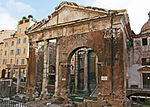Sant'Ambrogio della Massima
1606 establishments in Italy17th-century Roman Catholic church buildings in ItalyChurches of Rome (rione Sant'Angelo)Roman Catholic churches completed in 1606Roman Catholic churches in Rome

Sant'Ambrogio della Massima (also Sant'Ambrogio alla Massima) is a Roman Catholic church in rione Sant'Angelo, Rome, Italy, that perhaps dates to the 4th century. It was a convent until it became the subject of a Vatican investigation in the 19th century, when it was disbanded and repurposed as a missionary college and later an abbey church. It is said to have been associated with Saint Ambrose.
Excerpt from the Wikipedia article Sant'Ambrogio della Massima (License: CC BY-SA 3.0, Authors, Images).Sant'Ambrogio della Massima
Via di Sant'Angelo in Pescheria, Rome Municipio Roma I
Geographical coordinates (GPS) Address External links Nearby Places Show on map
Geographical coordinates (GPS)
| Latitude | Longitude |
|---|---|
| N 41.893166666667 ° | E 12.478333333333 ° |
Address
Sant’Ambrogio della Massima
Via di Sant'Angelo in Pescheria
00186 Rome, Municipio Roma I
Lazio, Italy
Open on Google Maps











